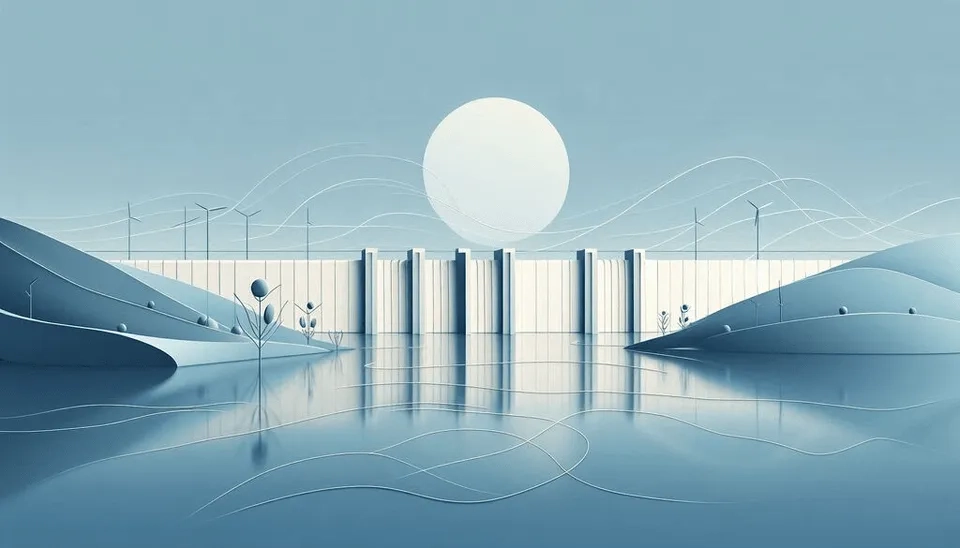
Water Reservoirs or Sediment Reservoirs?! Unbelievable but Possible!
Dams and reservoirs have been built in response to population growth and meeting needs related to food, energy, and water. The continuation of population growth in the future indicates the continuation of the construction of dams and reservoirs, with the difference that more attention should be paid to better construction, preservation, and reduction of environmental effects (Chen et al., 2016). Despite the advantages and applications of reservoirs and dams, these dams face challenges such as sediment trapping. Achieving sustainable dams and reservoirs requires solutions for sediment trapping and management. Achieving this goal requires the promotion of long-term economic sustainability through continuous monitoring of bathymetry and reservoir storage losses, providing sediment trapping management solutions, and providing funds to address the sedimentation situation of dams and reservoirs (Kondolf et al., 2014).
Sediment trapping in dams and reservoirs in some countries occupies about 60–70% of the capacity of reservoirs. The sediment accumulation rate in dams and reservoirs is not constant over months and years, and the majority of sediment accumulation occurs in 2 to 4 months, accompanied by seasonal floods. Although the flood season months account for about half of the annual runoff, 80 to 90 percent of the sediments accumulated in dams and reservoirs are caused by the flood season months (Wang and HU., 2009). In this article, we will categorize practical solutions for sediment trapping and explain the various methods in each category completely and in detail.
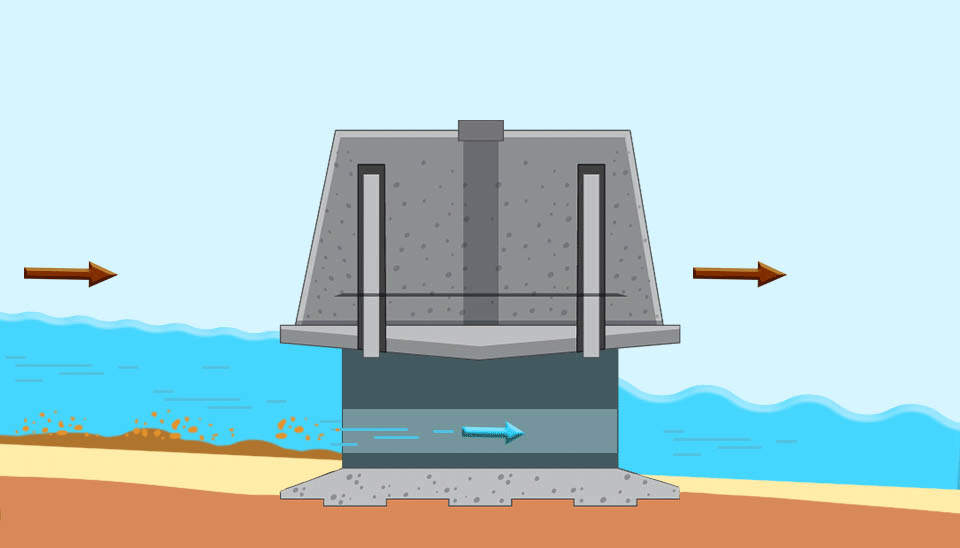
Table 1. Advantages and disadvantages of solutions to control sediment trapping in dams and reservoirs
Method | Advantages | Disadvantages |
Soil Erosion Control and Reduction | Enhance Soil Water Capacity Keep Soil Organic Matter Strengthen Biodiversity Runoff Management | Require Large-Scale Solution |
Upstream Sediment Trapping Storage | Practical for Small Watersheds | Lost Efficiency after Filling Less Effective for High Sedimentation Areas High Construction and Maintenance Costs |
Off-stream Storage (Reservoir or Storage outside the River Channel) | Positive Geomorphic and Ecological Effects Multipurpose Applications (Hydropower, Daily Storage Regulation, and Water Supply) Prevent Overtopping Hazards | Limited Capacity |
Sediment Bypass System | High Performance and Yield | High Maintenance and Construction Cost Low Lifetime (Gradually Damaged) |
Sediment Turbidity Current Venting | Economic and Effective Method Less Environmental Impact Widely Used | Depends on Various Factors |
Sediment Sluicing | Low Suspended Sediment Production Environmentally Friendly Economical Method | Depends on Upstream Inflow Low Performance in Large Reservoirs |
Compartmented Reservoirs (Main and Sediment Storage Reservoirs) | Flood Control Improve the Reliability of the Reservoir | Complex Geometric Shape Reducing the Reservoir Capacity |
Flushing (Pressure and Empty Flushing) | Different Kinds of Flushing Accelerating Empty Flushing with Flooding | Depends on Various Factors Require High Inflow Emptying the Reservoir |
Sediment Dry Excavation | Possibility of Gathering Coarse Materials and Sediments Effective in Deltas and Shallow Reservoirs | Emptying the Reservoir Transportation Requirement Emptying the Reservoir |
Sediment Dredging | Reuse of Dredged Sediments | Costly Method Low Efficiency in Large Reservoirs |
To Download Advantages and disadvantages of solutions to control sediment trapping in dams and reservoirs Click
1. Sediment Trapping Solutions in Dams and Reservoirs
Dams and reservoirs are important for flood control, water supply, hydroelectric power generation, and reliable water sources. However, sediment trapping in dams and reservoirs reduces their efficiency and results in physical, chemical, and biological effects. The effects of sediment trapping in dams and reservoirs were examined in Section 2. Therefore, it is necessary to obtain sustainable strategies and solutions to deal with sediment trapping in dams and reservoirs. Sediment trapping solutions in dams and reservoirs are generally divided into three categories:
1. Reducing the yield and volume of sediment from the watershed
2. Construction of secondary routes for the passage of streams with high sediment or installation of a sediment storage reservoir
3. Reducing and removing sediments deposited and accumulated in reservoirs and dams
Successful management of sediment trapping in dams and reservoirs requires multilateral and integrated strategies to provide the benefits of water storage for present and future generations by controlling the volume of sediments in reservoirs and dams (Morris, 2020). In the following, the sediment trapping solutions in dams and reservoirs will be discussed in detail.
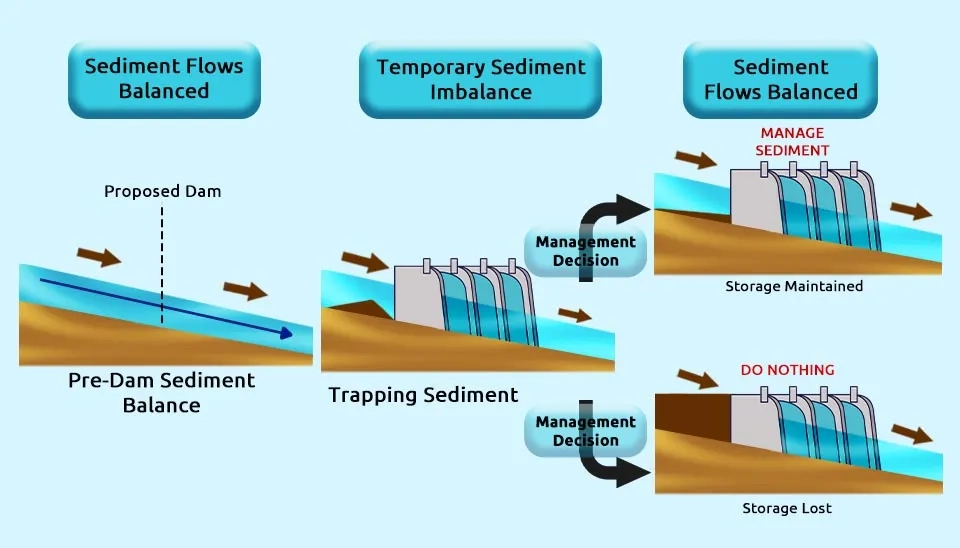
2. Sediment Trapping Solutions
In this article, three categories of sediment trapping management and different methods for each category are discussed, including:
2.1. Reducing the Yield and Volume of Sediment
A way to stop sediment from getting stuck in dams and reservoirs is to build upstream sediment storage and stop and control soil erosion. Here are some more details on how to do these things.
2.1.1. Soil Erosion Control and Reduction
Soil erosion, especially the erosion of steep hills, transfers a significant volume of sediments to water sources. Climate change and future weather patterns have increased the rate of soil erosion, and it is expected that the effects of sediment and pollutants related to it on the water quality of rivers and other water sources will be more significant in the future. Therefore, measures to control and prevent soil erosion have been designed to reduce the amount of produced sediment and to prevent the transfer of sediments on the hillsides (Rickson, 2014).
Soil erosion causes various damages to water resources and other ecosystems by reducing water holding capacity and reducing soil organic matter, such as reducing nutrients and reducing the diversity of plants, organisms, microbes, and animals. One of the most effective and functional measures to reduce and control soil erosion is the revitalization and creation of vegetation. Creating vegetation by increasing biodiversity in hills and areas with steep slopes helps to maintain soil characteristics and is related to runoff management and erosion control. Therefore, it is necessary to obtain new strategies related to the creation of vegetation on a large and practical scale to ultimately help sediment trapping in rivers, downstream dams and reservoirs (Zuazo and Pleguezuelo, 2009)
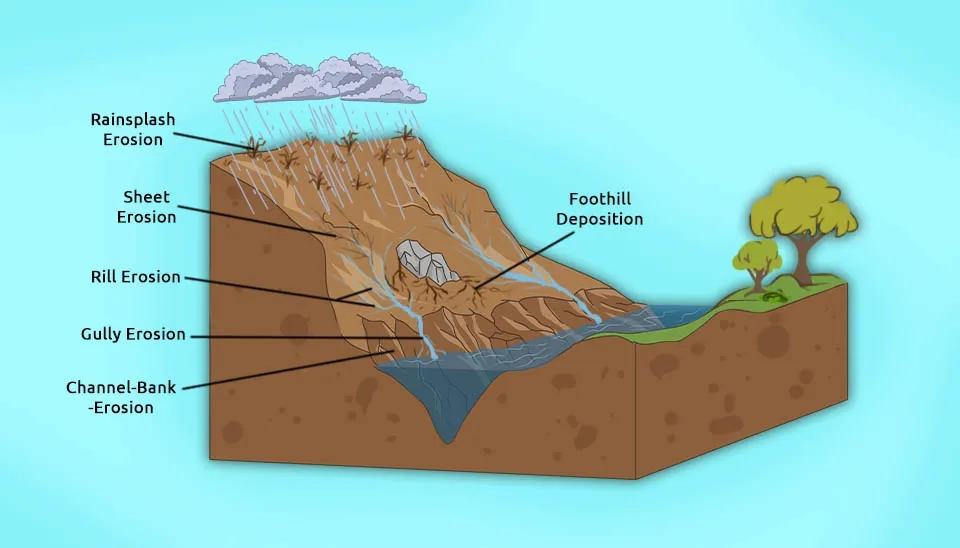
2.1.2. Upstream Sediment Trapping Storage
One of the methods for sediment trapping is the construction of hydraulic structures upstream of reservoirs and dams. Although upstream sediment trapping storage is a limiting factor in sediments leading to dams and reservoirs, compared to soil erosion control and reduction methods, it is less effective and useful because upstream sediment trapping storage is effective until it is filled with sediment and cannot control sediment trapping after filling. Upstream sediment trapping storage is more practical for small watersheds and basins, such as farms, and helps conserve farm water. However, upstream sediment tapping storage is not only practical and sustainable in large watersheds with high sedimentation but also has high construction and maintenance costs and limited control and maintenance volume, making it not economical compared to other sediment trapping solutions (Minear and Kondolf, 2009; Wang and Kondolf, 2013)

2.2. Sediment Routing
This category of sediment trapping control solutions relies on the reservoir or the secondary path so that the sediments are transferred downstream by passing through the dam and the reservoir or from its side. Sediment routing methods include sediment sluicing, sediment turbidity current venting, sediment bypass systems, and off-stream storage, which are explained in detail below.
2.2.1. Off-stream Storage (Reservoir or Storage outside the River Channel)
One of the methods of sediment routing is the construction of a reservoir or storage outside the river channel (off-stream storage) in a high area or by impounding a tributary. The flow with high sediments and coarse bed loads is trapped and remains in the river channel before it reaches the dams and reservoirs. On the other hand, pumping or gravity pulls the clean water out of the river channel and transfers it to the off-stream storage. Storage outside the main river channel can reduce a significant volume of sediment leading to dams and reservoirs and have other benefits in addition to geomorphic and ecological importance. Storage outside the main river channel is used in the production of renewable energy through hydropower and helps to regulate the daily storage and supply of water needs. Creating storage outside the river channel reduces the overflow capacity for the operational period and the size of river diversion and helps to reduce overtopping hazards and costs (Morris, 2020).
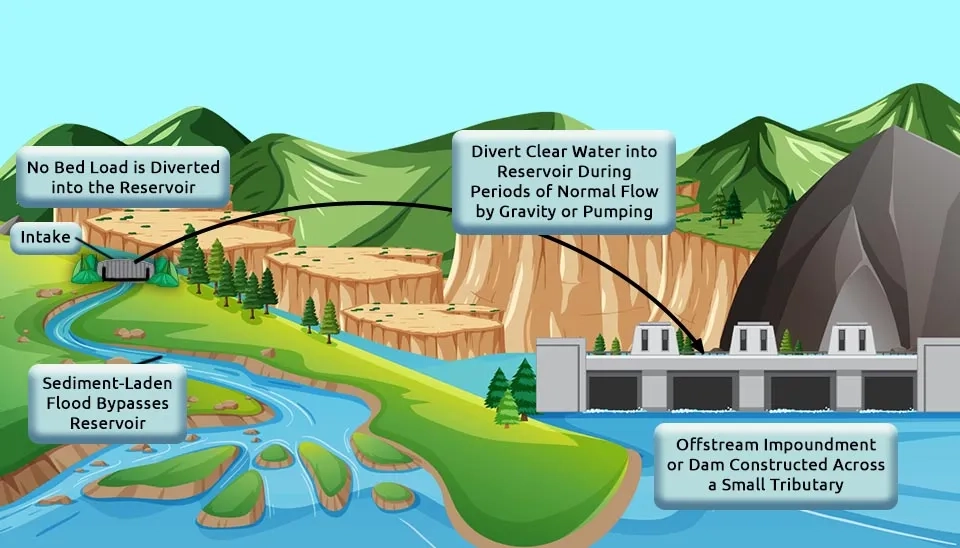
2.2.2. Sediment Bypass System
The sediment bypass system prevents the transfer of sediment to reservoirs and dams and sediment trapping by diverting a part of the incoming flow with high sediment. The sediment bypass system is designed in two forms: tunnels and channels, and it is installed along dams and reservoirs so that the flow of high sediment upstream of the reservoir is directed into the tunnel or diversion channel with high capacity and rejoins the river downstream of the dam and reservoir. The sediment bypass system has received attention in Japan and Switzerland and is widely used in reservoirs and dams. (Kondolf et al., 2014).
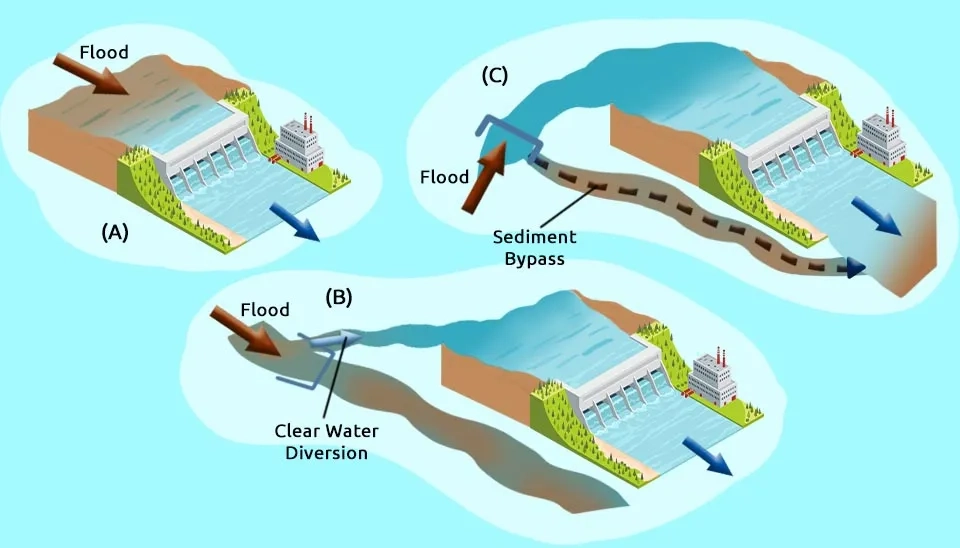
Sediment bypass systems, despite their high performance in controlling sediment trapping in dams and reservoirs, require high construction costs. In addition to the high construction costs, invert abrasion due to the flow with high sediments has gradually damaged the sediment bypass systems and caused more secondary maintenance costs to maintain the system's performance (Auel 2014).
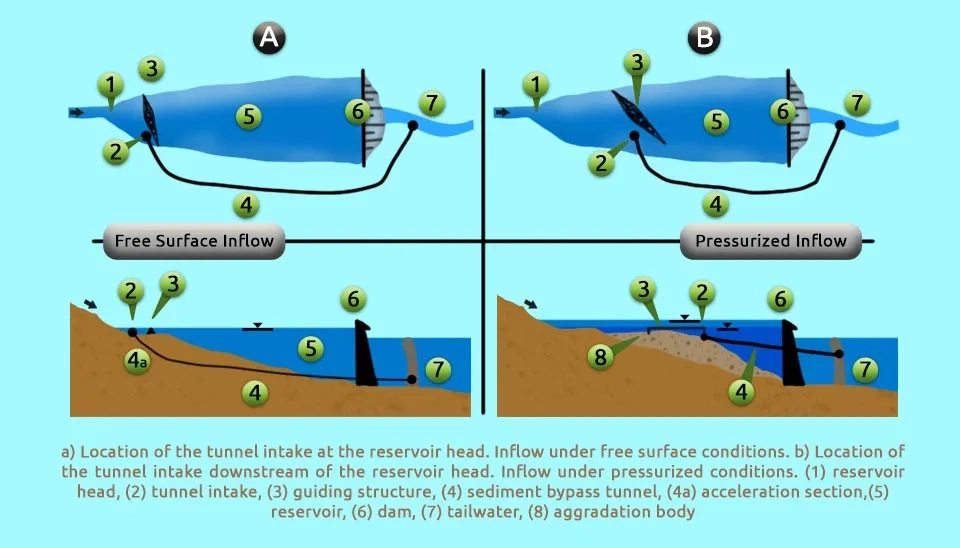
2.2.3. Sediment Turbidity Current Venting
Turbidity current venting is one of the most economical and effective methods to control sediment trapping in dams and reservoirs. Turbidity current venting is preferred over other solutions for sediment trapping due to economic reasons and less negative effects on the downstream ecosystem, especially when suspended sediments are the main source of sediment in reservoirs. The process of turbidity current venting is such that when the turbidity current reaches the dam, the lower outlets are opened so that the dense current with high sediments passes downstream of the dam. Ideally, all turbidity current is expected to pass through the dam and reservoir. Achieving the ideal state and increasing the efficiency of turbidity current venting requires various factors, such as a steep slope, a short reservoir length, a high output flow rate, a large amount and high concentration of fine input sediments, as well as small and large outputs. On the other hand, the output of the dams should be such that a significant volume of reservoir water is not wasted and there are no economic or ecological effects so that sediments can be discharged without reducing the volume of reservoir water. Turbidity current venting helps to increase the life of the reservoir and requires the use of optimal methods; however, it is recommended to perform regular and periodic turbidity current venting from the beginning of the establishment of the reservoir. Turbidity current venting is used in the United States of America, China, Iran, Switzerland, and North Africa (Chamoun et al., 2016).
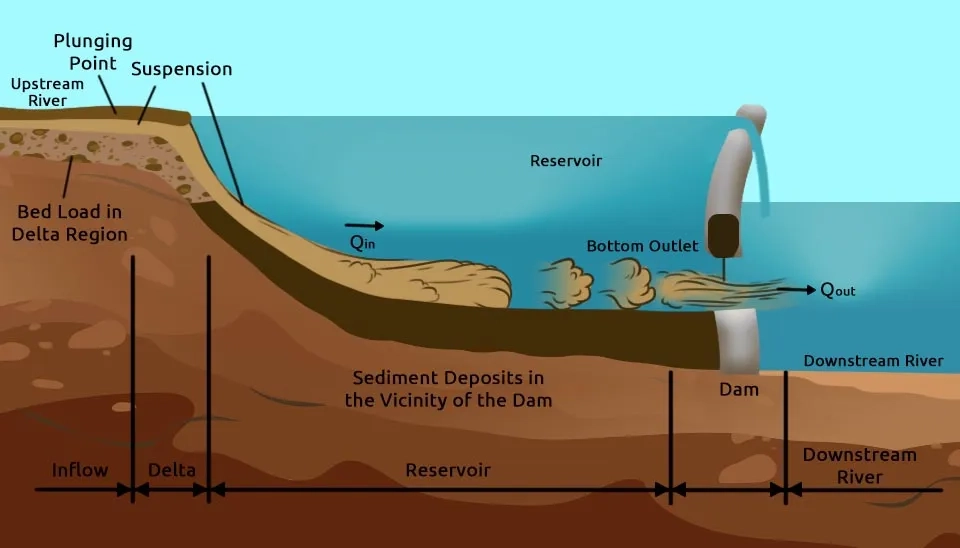
2.2.4. Sediment Sluicing
Sediment sluicing is a process in which the volume and flow rate of sediment passing through the reservoir are maximized by lowering the water level during floods so that the sediments pass through the reservoir and the dam at a faster rate. During the flood, the speed of the flow increases. In sediment sluicing, the speed of the flow passing from the reservoir to the downstream side is equal to the speed of the flow entering the reservoir from the upstream side. Increasing the speed of the outflow of sediments reduces the retention time and prevents sediment trapping in dams and reservoirs. In appearance, sediment sluicing is similar to sediment bypass; while sediment bypass diverts the flow with high sediment and the sediment does not reach the dam, in the sediment sluicing method, the flow with high sediment passes through the dam or near it. Sediment sluicing does not produce high suspended sediment and its maximum flow rate is lower than the flow rate of some methods, such as flushing, so it has no environmental consequences and is considered environmentally friendly. Sediment sluicing has better performance in small reservoirs that have a deep outlet with a high capacity and low level and is generally considered a low-cost method that improves the lifespan of the reservoirs(Morris, 2020).
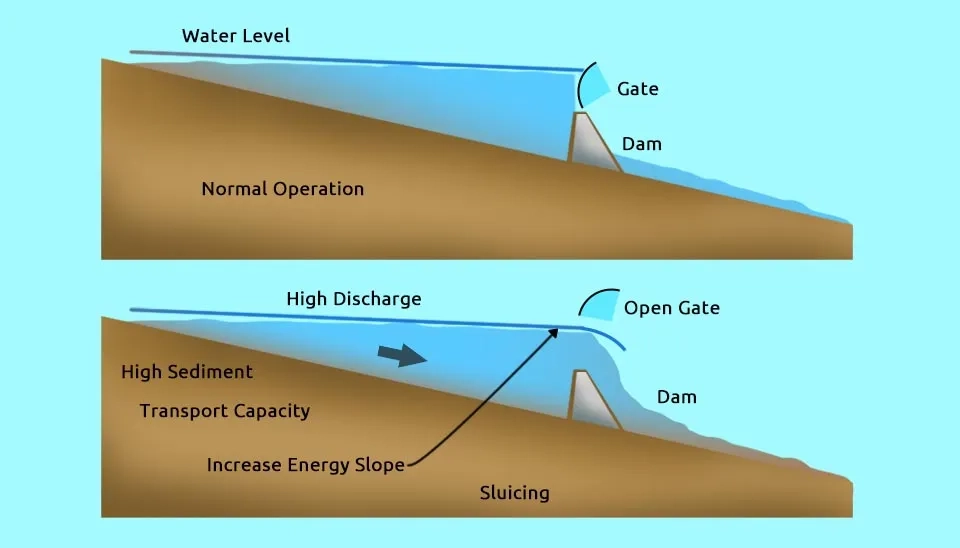
2.2.5. Compartmented Reservoirs (Main and Sediment Storage Reservoirs)
In the compartmented reservoir method, an internal reservoir or barrier is used so that the flow with high sediment does not enter the main reservoir and is trapped in the built-in reservoir. In other words, the reservoir is divided into a main reservoir and a sediment storage reservoir (smaller than the main reservoir), which can have different levels. The geometry of the sediment storage reservoir should be such that the flow with high sediments is released downstream without entering the main reservoir. The compartmented reservoir method not only helps the reliability of the main reservoir and stabilizes the water levels in the main reservoir, but also improves flood control (Morris, 2020; Wulandari et al., 2010).
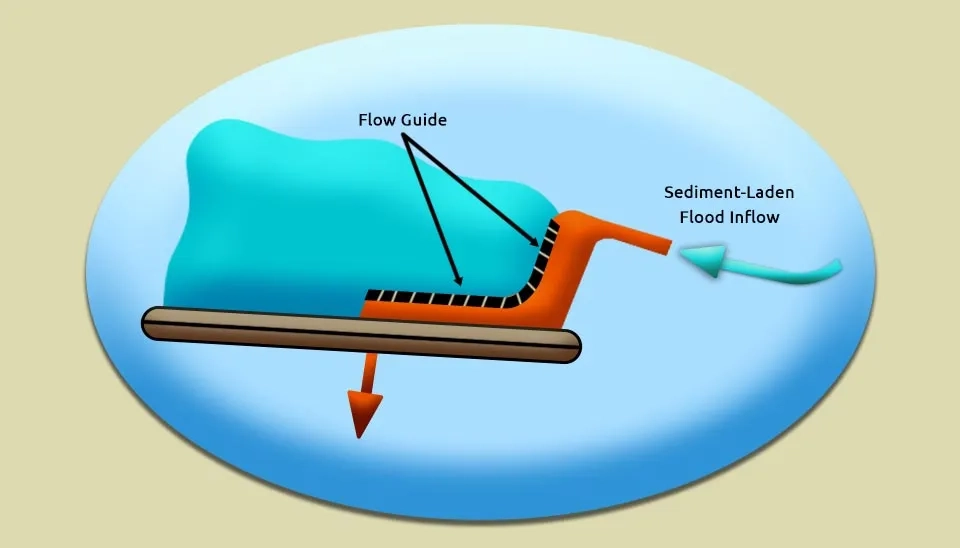
2.3. Sediment Removal
Sediment removal methods include flushing (pressure and empty flushing), dry excavation, and sediment dredging. Sediment removal methods do not remove sediments from the inflow since they collect and remove sediments after reaching and accumulating in dams and reservoirs.
2.3.1. Flushing (Pressure and Empty Flushing)
In sediment flushing, low-level outlets of the reservoir are opened so that the reservoir is emptied and the sediments settle out of the reservoir through the establishment of the river flow along the flow route. Flushing is done in two ways: empty or free-flow flushing and drawdown or pressure flushing. In pressure flushing, the level of the reservoir is high so that, by creating pressure in the submerged outlet, the sediments are removed from the low-level outlet. In pressure flushing, the sediments located near and upstream of the outlet are removed from the reservoir and dam. Pressure flushing requires less drawdown and is less effective compared to empty flushing.
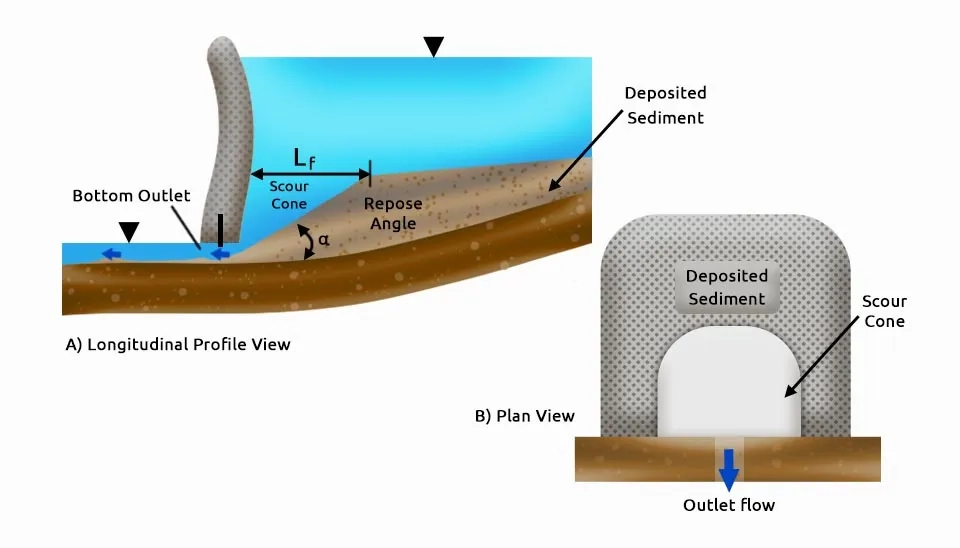
Empty or free-flow flushing involves emptying the reservoir along with accumulated sediments with the river flow. In empty flushing, first, the level of the reservoir is lowered so that the upstream sediments are washed and moved toward the outlet. As the free-flow period approaches, the concentration of sediments near the reservoir is maximized until the reservoir begins to refill and the sediments are transferred to the downstream river. The function and capability of flushing in controlling sediment trapping depend on several factors, including water availability and cost, timing, reservoir geometry, sediment properties, sizing, and positioning of the outlet (Petkovšek et al., 2020). In general, empty flushing with flooding is more effective and sediments can be emptied from the reservoir more efficiently by providing more erosion energy and a larger discharge flow (Wang and Hu, 2009)
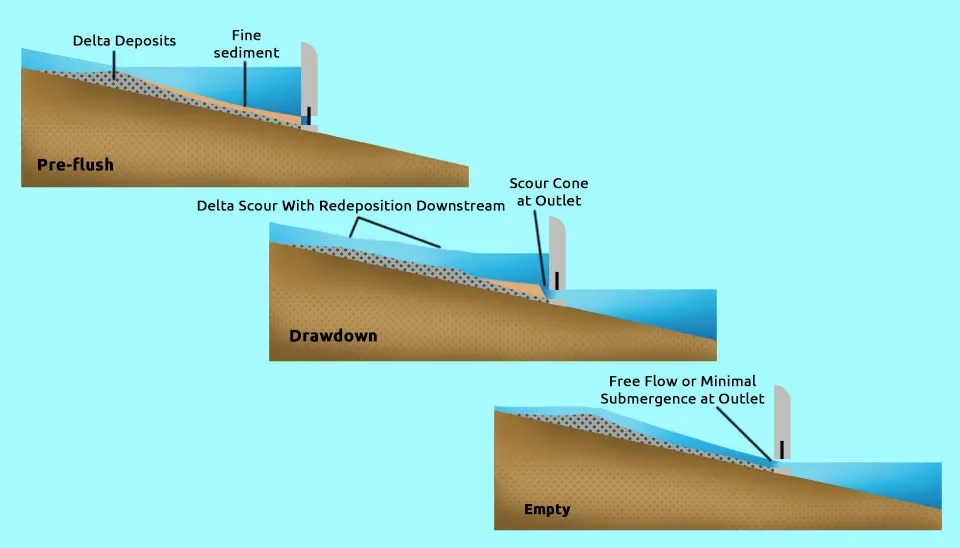
2.3.2. Sediment Dry Excavation
The dry excavation of sediments is done by reducing the level of the reservoir and allowing the excavation equipment to access the sediments in the dam bed. Dry excavation provides the possibility of collecting coarse materials and sediments; however, it faces challenges and limitations related to transportation and the high volume of sediments. Dry drilling is more efficient in deltas and shallow reservoirs that are associated with seasonal water changes (Morris, 2020).
-67913283490d53cba5255e64)
2.3.3. Sediment Dredging
Sediment dredging involves mechanical and hydraulic dredging to collect sediment underwater and remove it from dams and reservoirs. In dredging with mechanical lifting, sediments are collected by backhoe, clamshell, dragline, and bucket ladder and removed from the environment by trucks or other vehicles. Hydraulic dredging transfers the sediment to the river downstream of the dam or to the storage tank by creating a slurry of sediment and water in a pipeline. Dredged sediments can be reused for different applications, such as agriculture. However, one of the challenges of dredging is its high cost, which can be reduced by transferring sediments to the downstream river. Dredging is not efficient in large reservoirs compared to small reservoirs due to the production and separation of high-volume sediments and the lack of space to dispose of sediments. Sediment dredging is not considered a sustainable solution for sediment trapping management (Morris, 2020). Hydrosuction sediment removal systems (HSRS) are one of the types of sediment dredging that use the energy difference between the water level upstream and downstream of the reservoir (Hotchkiss and Huang, 1995).
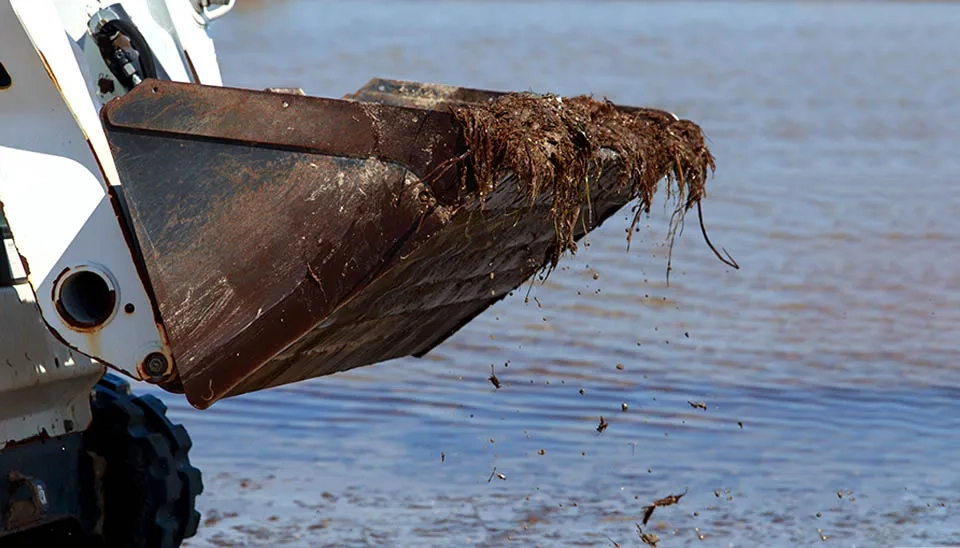
3. Conclusion
The continuous increase in the volume of sediment in reservoirs and dams brings many challenges. Sediments occupy the capacity of the reservoirs and disrupt the operation of the reservoir. Therefore, it is necessary to adopt sustainable strategies for sediment trapping management in dams and reservoirs to improve the lifespan of reservoirs. In this article, sediment trapping solutions were divided into three categories: 1) reducing the yield and volume of sediment; 2) sediment routing; and 3) sediment removal. The basis of this division is how to deal with sediments and collect them upstream or from reservoirs. Methods based on reducing the volume and yield of sediments are strategies to deal with sediments reaching reservoirs, including controlling and reducing soil erosion and upstream sediment trapping storage. Methods based on sediment routing (including sediment sluicing, sediment turbidity current venting, sediment bypass systems, and off-stream storage) seek to create a reservoir or a path so that sediments do not enter the reservoir or pass through the reservoir. The purpose of sediment removal methods is to directly extract and transport sediments from the bottom of reservoirs and dams, which includes flushing (pressure and empty flushing), dry excavation, and sediment dredging. Each of these methods has its advantages and disadvantages and is effective in different reservoirs. Some of the methods mentioned are not economically justified (such as upstream sediment trapping storage, sediment dredging, and dry excavation), and others are applicable in small reservoirs (such as sediment sluicing). In general, reducing the yield and volume of sediment by strengthening the vegetation in areas prone to sediment production (such as hillsides and steep slopes) is the best and most sustainable solution for sediment trapping management in dams and reservoirs.
